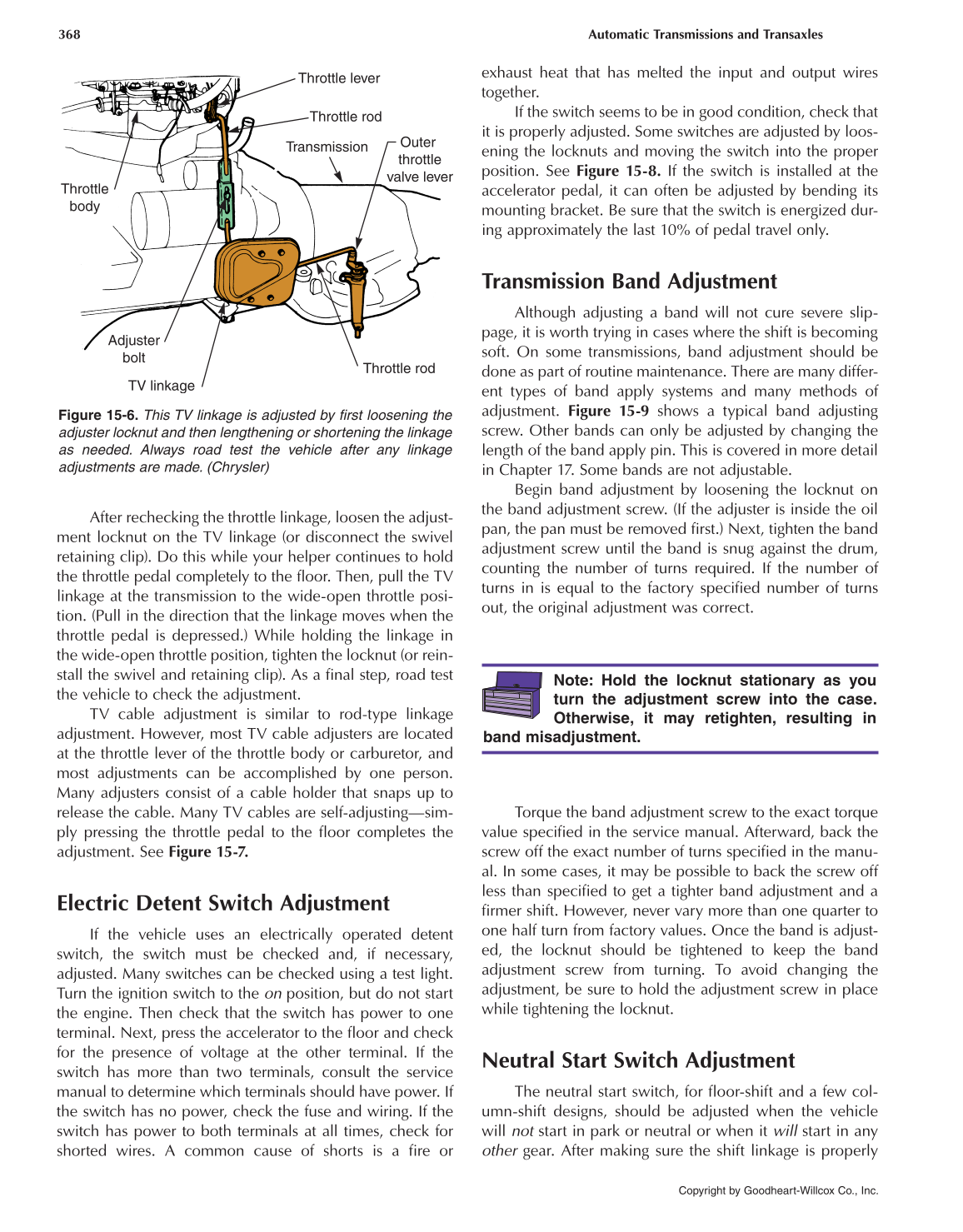Copyright by Goodheart-Willcox Co., Inc.
368 Automatic Transmissions and Transaxles
Adjuster
bolt
TV linkage
Throttle rod
Outer
throttle
valve lever
Transmission
Throttle rod
Throttle lever
Throttle
body
Figure 15-6. This TV linkage is adjusted by first loosening the
adjuster locknut and then lengthening or shortening the linkage
as needed. Always road test the vehicle after any linkage
adjustments are made. (Chrysler)
Note: Hold the locknut stationary as you
turn the adjustment screw into the case.
Otherwise, it may retighten, resulting in
band misadjustment.
After rechecking the throttle linkage, loosen the adjust-
ment locknut on the TV linkage (or disconnect the swivel
retaining clip). Do this while your helper continues to hold
the throttle pedal completely to the floor. Then, pull the TV
linkage at the transmission to the wide-open throttle posi-
tion. (Pull in the direction that the linkage moves when the
throttle pedal is depressed.) While holding the linkage in
the wide-open throttle position, tighten the locknut (or rein-
stall the swivel and retaining clip). As a final step, road test
the vehicle to check the adjustment.
TV cable adjustment is similar to rod-type linkage
adjustment. However, most TV cable adjusters are located
at the throttle lever of the throttle body or carburetor, and
most adjustments can be accomplished by one person.
Many adjusters consist of a cable holder that snaps up to
release the cable. Many TV cables are self-adjusting—sim-
ply pressing the throttle pedal to the floor completes the
adjustment. See Figure 15-7.
Electric Detent Switch Adjustment
If the vehicle uses an electrically operated detent
switch, the switch must be checked and, if necessary,
adjusted. Many switches can be checked using a test light.
Turn the ignition switch to the on position, but do not start
the engine. Then check that the switch has power to one
terminal. Next, press the accelerator to the floor and check
for the presence of voltage at the other terminal. If the
switch has more than two terminals, consult the service
manual to determine which terminals should have power. If
the switch has no power, check the fuse and wiring. If the
switch has power to both terminals at all times, check for
shorted wires. A common cause of shorts is a fire or
exhaust heat that has melted the input and output wires
together.
If the switch seems to be in good condition, check that
it is properly adjusted. Some switches are adjusted by loos-
ening the locknuts and moving the switch into the proper
position. See Figure 15-8. If the switch is installed at the
accelerator pedal, it can often be adjusted by bending its
mounting bracket. Be sure that the switch is energized dur-
ing approximately the last 10% of pedal travel only.
Transmission Band Adjustment
Although adjusting a band will not cure severe slip-
page, it is worth trying in cases where the shift is becoming
soft. On some transmissions, band adjustment should be
done as part of routine maintenance. There are many differ-
ent types of band apply systems and many methods of
adjustment. Figure 15-9 shows a typical band adjusting
screw. Other bands can only be adjusted by changing the
length of the band apply pin. This is covered in more detail
in Chapter 17. Some bands are not adjustable.
Begin band adjustment by loosening the locknut on
the band adjustment screw. (If the adjuster is inside the oil
pan, the pan must be removed first.) Next, tighten the band
adjustment screw until the band is snug against the drum,
counting the number of turns required. If the number of
turns in is equal to the factory specified number of turns
out, the original adjustment was correct.
Torque the band adjustment screw to the exact torque
value specified in the service manual. Afterward, back the
screw off the exact number of turns specified in the manu-
al. In some cases, it may be possible to back the screw off
less than specified to get a tighter band adjustment and a
firmer shift. However, never vary more than one quarter to
one half turn from factory values. Once the band is adjust-
ed, the locknut should be tightened to keep the band
adjustment screw from turning. To avoid changing the
adjustment, be sure to hold the adjustment screw in place
while tightening the locknut.
Neutral Start Switch Adjustment
The neutral start switch, for floor-shift and a few col-
umn-shift designs, should be adjusted when the vehicle
will not start in park or neutral or when it will start in any
other gear. After making sure the shift linkage is properly
